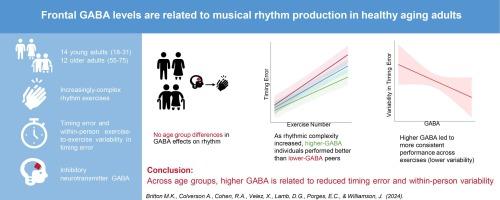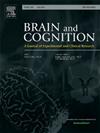额叶 GABA 水平与健康老年人音乐节奏的产生有关
IF 1.4
3区 心理学
Q3 NEUROSCIENCES
引用次数: 0
摘要
神经元抑制的变化与年龄相关的感觉运动能力下降有关。虽然有间接证据表明抑制机制也参与了节奏控制,但这种关联尚未得到检验。我们使用磁共振波谱法测试了健康的年轻人(n = 14;18-35 岁)和老年人(n = 12;55-79 岁)背内侧额叶 GABA+/H2O 浓度与音乐节奏产生之间的关联,并假设 GABA+/H2O 浓度较低将与计时误差增加(尤其是在难度较大的练习中)和个体内部变异性(通过平均连续平方差(MSSD)量化)有关。节奏学习练习按复杂程度依次进行。线性混合效应模型显示,GABA+/H2O与练习次数之间存在交互作用(β = -0.59,p = 0.006),GABA+/H2O越低的参与者,随着练习难度的增加,成绩下降幅度越大。GABA+/H2O 与 MSSD 呈反向关系(β = -0.25,p = 0.089),因此 GABA+/H2O 越高,成绩的可变性越低。年龄越大,绝对计时误差越大(β = 0.66,p = 0.001),MSSD 越大(β = 0.86,p = 0.012)。然而,没有证据表明 GABA+/H2O-表现关系存在年龄组差异。这一结果表明,GABA能神经元抑制可能在不同年龄组的音乐节奏产生中起着重要作用。本文章由计算机程序翻译,如有差异,请以英文原文为准。

Frontal GABA levels associate with musical rhythm production in healthy aging adults
Changes in neuronal inhibition have been implicated in age-related declines in sensorimotor performance. While indirect evidence suggests that inhibitory mechanisms are also involved in rhythm entrainment, this association has not been tested. Using magnetic resonance spectroscopy, we tested the association between dorsomedial frontal GABA+/H2O concentrations and musical rhythm production in healthy younger (n = 14; 18–35) and older (n = 12; 55–79) adults, hypothesizing that lower GABA+/H2O concentrations would be associated with increased timing error, particularly on more difficult exercises, and intra-individual variability (quantified via mean successive squared difference (MSSD)). Rhythm learning exercises were presented in order of complexity. Linear mixed effects modeling revealed GABA+/H2O-by-exercise number interaction (β = -0.59, p = 0.006) such that participants with lower GABA+/H2O showed greater performance decrement with increasing exercise difficulty. GABA+/H2O trended toward an inverse association with MSSD (β = -0.25, p = 0.089), such that higher GABA+/H2O was associated with lower variability in performance. Older age was associated with increased absolute timing error (β = 0.66, p < 0.001) and greater MSSD (β = 0.86, p = 0.012). However, there was no evidence for age group differences in GABA+/H2O−performance relationships. This finding suggests that GABAergic neuronal inhibition may be important in musical rhythm production across age groups.
求助全文
通过发布文献求助,成功后即可免费获取论文全文。
去求助
来源期刊

Brain and Cognition
医学-神经科学
CiteScore
4.60
自引率
0.00%
发文量
46
审稿时长
6 months
期刊介绍:
Brain and Cognition is a forum for the integration of the neurosciences and cognitive sciences. B&C publishes peer-reviewed research articles, theoretical papers, case histories that address important theoretical issues, and historical articles into the interaction between cognitive function and brain processes. The focus is on rigorous studies of an empirical or theoretical nature and which make an original contribution to our knowledge about the involvement of the nervous system in cognition. Coverage includes, but is not limited to memory, learning, emotion, perception, movement, music or praxis in relationship to brain structure or function. Published articles will typically address issues relating some aspect of cognitive function to its neurological substrates with clear theoretical import, formulating new hypotheses or refuting previously established hypotheses. Clinical papers are welcome if they raise issues of theoretical importance or concern and shed light on the interaction between brain function and cognitive function. We welcome review articles that clearly contribute a new perspective or integration, beyond summarizing the literature in the field; authors of review articles should make explicit where the contribution lies. We also welcome proposals for special issues on aspects of the relation between cognition and the structure and function of the nervous system. Such proposals can be made directly to the Editor-in-Chief from individuals interested in being guest editors for such collections.
 求助内容:
求助内容: 应助结果提醒方式:
应助结果提醒方式:


